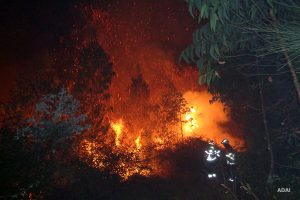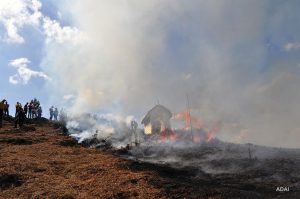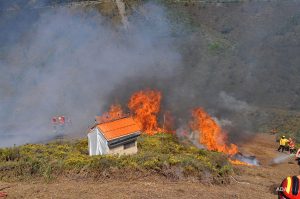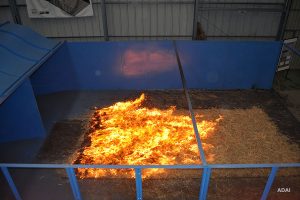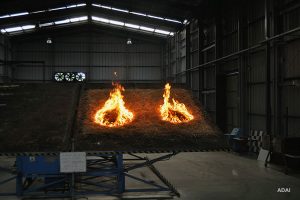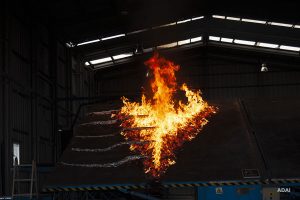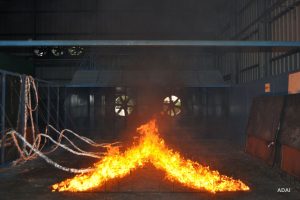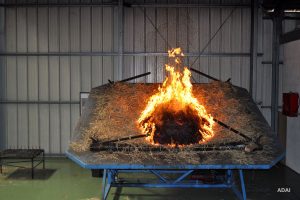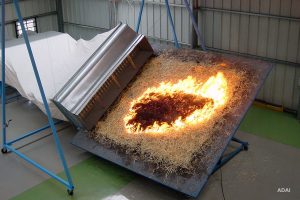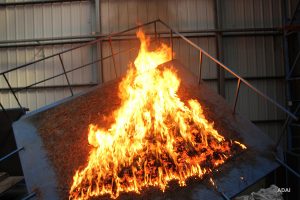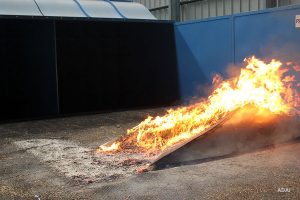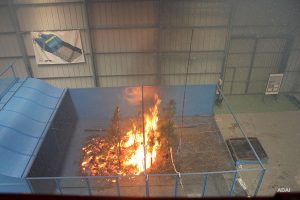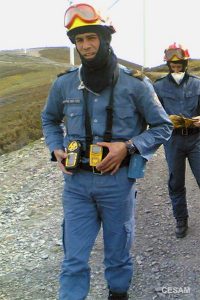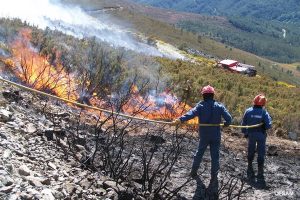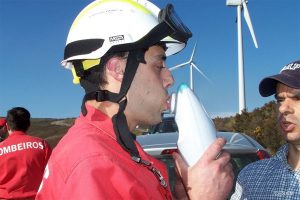Outcomes
Deliverables list
View document
Deliverable Leader: IPMA
Available at 2020-08-31
View document
Deliverable Leader: IPMA
Available at 2021-08-31
View document
Deliverable Leader: IPMA
Available at 2022-01-31
View document
Deliverable Leader: IPMA
Available at 2022-01-31
View document
Deliverable Leader: ADAI
Available at 2021-11-30
View document
Deliverable Leader: ADAI
Available at 2021-11-30
View document
Deliverable Leader: ADAI
Available at 2021-11-30
View document
Deliverable Leader: CESAM
Available at 2022-01-31
View document
Deliverable Leader: ADAI
Available at 2022-01-31
View document
Deliverable Leader: ADAI
Available at 2022-01-31
Image Gallery
-
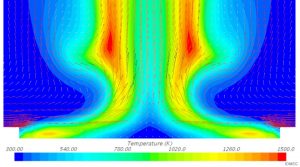
- The image shows the velocity vectors and temperature isocontours of the near field of a fire whirl. It is part of an ongoing study on vortex breakdown in fire whirls.
-

- The image shows the temperature isocontours of a 2D fire simulation. It is part of an ongoing study on fire propagation using a user built library for fire simulation in Star-CCM+.
-

- The image shows the isocontours of mixture fraction = 0.44 in a 3D simulation of a line of fire not perpendicular to the wind direction. It is part of an ongoing study on fire propagation using a user built library for fire simulation in Star-CCM+.
Video Gallery
Publications
On the non-monotonic behaviour of fire spread
- AUTHORS: Viegas DX; Raposo J; Ribeiro C; Reis L; Abouali A; Viegas C
- SUBJECT: Paper publish in International Journal of Wildland Fire
A conceptual model based on the dynamic interaction between fire, the fuel bed and the surrounding flow to explain the non-monotonic or intermittent behaviour of fires is proposed. According to the model, even in nominally permanent and uniform boundary conditions, the fire-induced flow modifies the geometry of the flame and its rate of spread. After an initial acceleration, there is a reduction in the rate of spread followed by one or more cycles of growth. Carefully controlled experiments of fires in slopes and canyons show that the evolution of fire properties, namely flame angle and rate of spread, have high-frequency oscillations superimposed on the low-frequency fire growth cycle described above.
The climatology of extreme wildfires in Portugal, 1980–2018: Contributions to forecasting and preparedness
- AUTHORS: Carmo M; Ferreira J; Mendes M; Silva A; Silva P; Alves D; Reis L; Novo I; Viegas DX
- SUBJECT: Paper publish in International Journal of Climatology
Available research has extensively examined the spatiotemporal patterns of fire-weather regime in Portugal, but a comprehensive climatology of extreme wildfires is still under development. This study calls for different strategies and scales of analysis aiming to describe the relationships between medium and low troposphere weather conditions and severe fire behaviour in mainland Portugal, between 1980 and 2018. In particular, critical fire-weather patterns and thresholds that can contribute to operational and forecasting know-how in short and medium time ranges are presented. We updated the general trends in the fire regime with a new, longer daily burned area series and developed a method that identifies Extreme Wildfire Periods (EWP) that form the basis for climate analysis. Synoptic analysis using Circulation Weather Types (CWT) showed that the northeasterly and easterly directional flows are significantly associated with EWP and produce the most severe fire-weather conditions. The four main CWT related to extreme fire are driven from anticyclones over the eastern Atlantic between the Azores and the British Isles. However, severe situations can also be regulated by CWT with marginal presence in both summer and EWP: low systems located to the west and northwest of Iberia carrying air masses from the south quadrant are related to catastrophic events. Regarding the antecedent climate, the results indicate that the coincident meteorological drought, whether weak or intense, is a necessary but not sufficient condition for the development of an EWP. An increasing relevance of water stress for shorter intervals preceding EWP, in the order of days and weeks, is apparent. Following these results, fine dead fuel moisture thresholds related to transitions in fire behaviour in Portuguese landscapes are computed using a promising predictive moisture content model. Finally, the different methods used are summoned for the detailed analysis of an EWP starting under unusual synoptic circulation.
Influence of Convectively Driven Flows in the Course of a Large Fire in Portugal: The Case of Pedrógão Grande
- AUTHORS: Pinto P; Silva AP; Viegas DX; Almeida M; Raposo J; Ribeiro LM
- SUBJECT: Paper publish in MDPI Atmosphere
The influence of a mesoscale convective system (MCS) in the evolution of two wildfires that started during the afternoon of 17 June 2017 in Pedrógão Grande, Central Portugal is discussed and analysed using weather radar data, weather stations, video images and fire spread analysis. As the MCS approached the region, its convectively driven flows started to influence the fires. The overturning flows were formed by two main limbs: one organised as front-to-rear deep layer inflows that propagated over the convective region of the MCS and the other as rear-to-front mid-level inflows that descended below the anvil structure of the MCS. The rear-to-front inflows, while accelerating and descending to lower levels, contributed to modify the fires’ intensity and plume characteristics. After the two fires merged, the resulting junction fire became very intense and impossible to control. Then, a firestorm was generated, causing the deaths of 66 people. The main goal of this study is to detail the influence of the MCS in the fire spread, thus contributing to the general knowledge of outstanding fire behaviour modifications due to the influence of atmospheric convective processes.
Double S-type Pitot Tube for velocity field study of fire whirls
- AUTHORS: Pinto C; André J; Viegas DX
- SUBJECT: Paper publish in Flow Measurement and Instrumentation
In this paper we present a pressure measurement instrument based on the S-type Pitot tube modified to measure the two velocity components of a high temperature flow assuming that the flow is locally two-dimensional. The development of this new device, which we designate as the Double S-type Pitot Tube, is related to the difficulty and the lack of precision of measurements with a standard S-type Pitot tube in flows with unknown directions like the case of fire whirls in laboratory experiments. The design, construction and calibration method of the device are described. The pitch angle of the flow and the velocity coefficients of the probe are analysed experimentally in a wind tunnel calibration as well as the associated errors. The use of this sensor in a fire whirl laboratory test is shown and the results are compared with those of simple S-type Pitot tubes in the same test. The obtained results show the applicability and better performance of the novel device.
Effect of Canyons on a Fire Propagating Laterally Over Slopes
- AUTHORS: Rodrigues A; Ribeiro C; Raposo J; Viegas DX; André J
- SUBJECT: ...
In this paper, the problem related with a fire front propagating laterally on a slope with a nearby canyon is presented. The presence of the canyon can modify the intensity of the fire and create a difficult situation for elements involved in fire suppression. When a fire propagating laterally in a slope enters the canyon, a rapid increase in the fire’s rate of spread occurs and a strong convective activity is generated due to the burning inside the canyon. The convective flow generated will then induce a change in the propagation of the fire in the slope. In certain conditions the rate of spread and the intensity of the fire will be strongly increased. This type of extreme fire behavior is referred to as eruptive fire behavior (or blow-up), and usually happens over slopes or in canyon configurations. In this study, we analyzed the results of laboratory-scale experiments that model a fire spreading latterly over a slope and then enter a canyon that is embedded in the slope. Three configuration parameters were used in the experiments. The first is the inclination α of the slope, the second is the orientation γ of the axis of the canyon and the third is the angle β of the ignition line. The fire spread is very complex and dynamic resulting in situations in which very high values of the ROS can be reached for several configurations, creating dangerous situations for firefighters.
